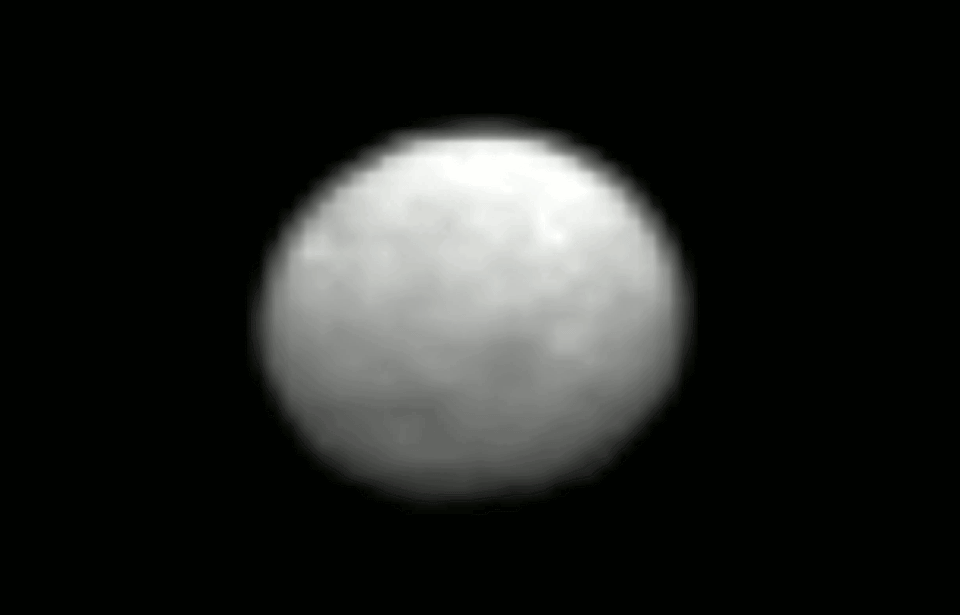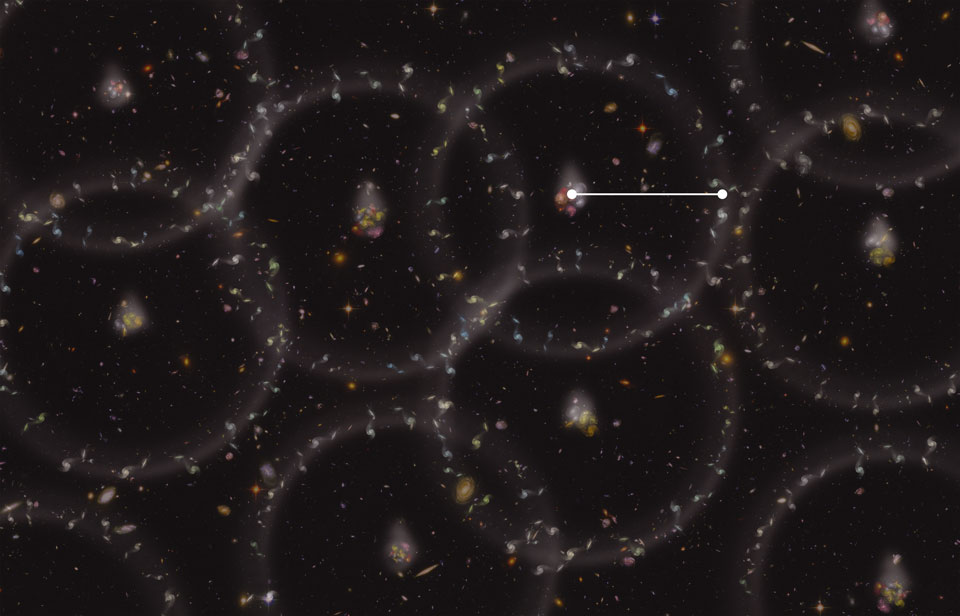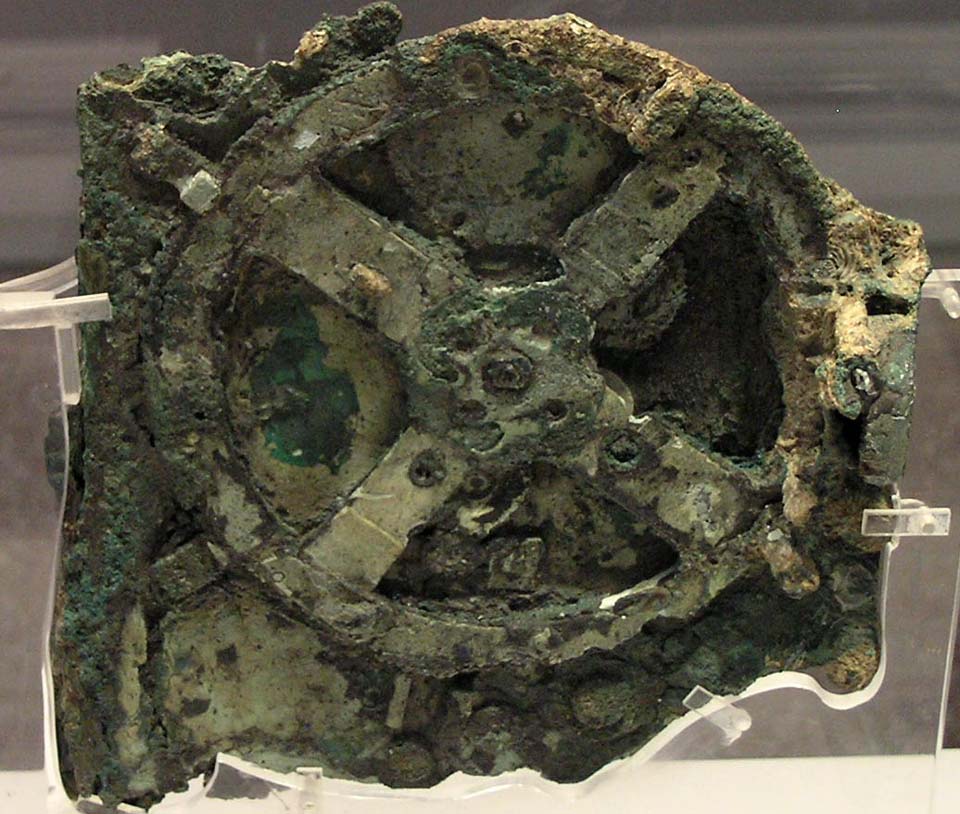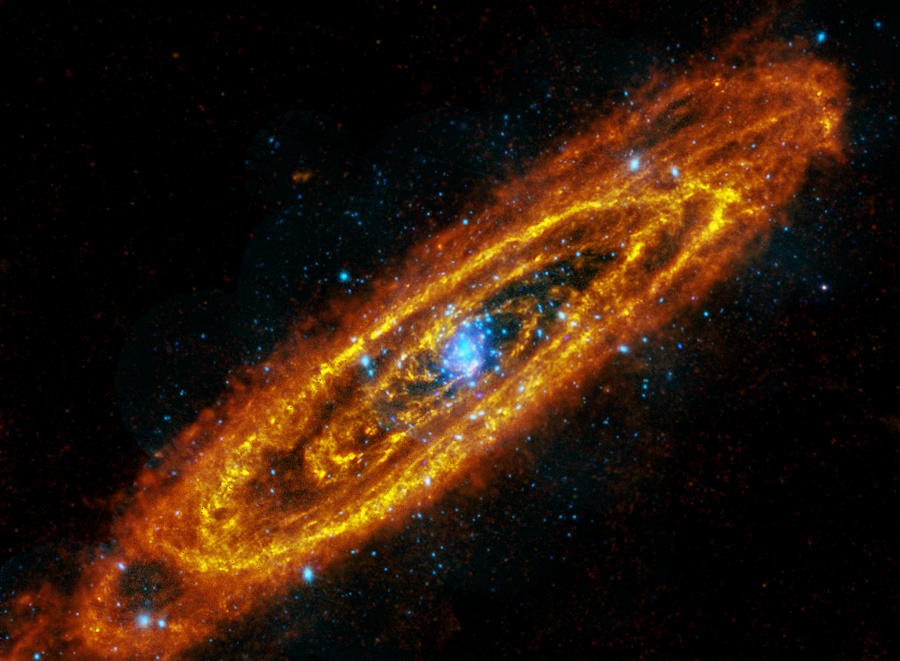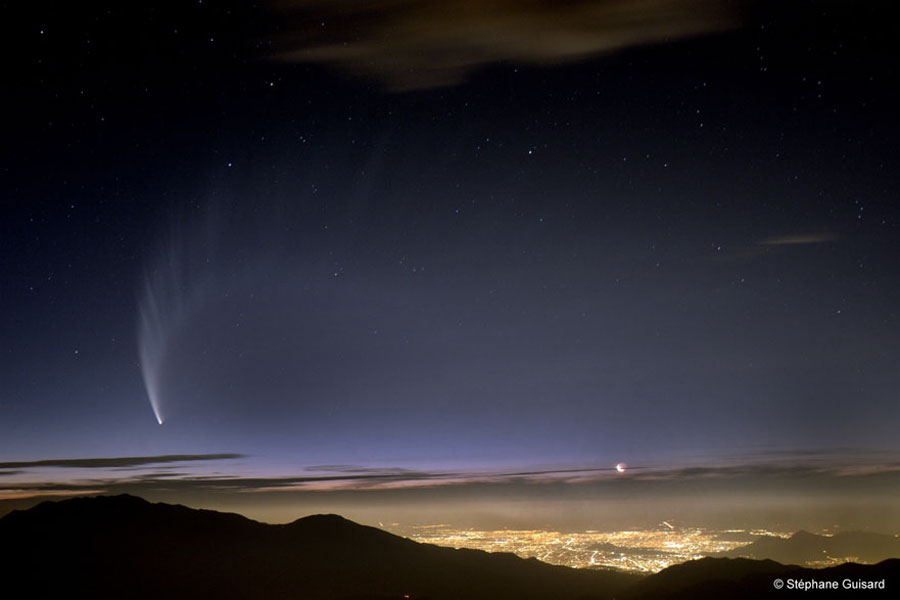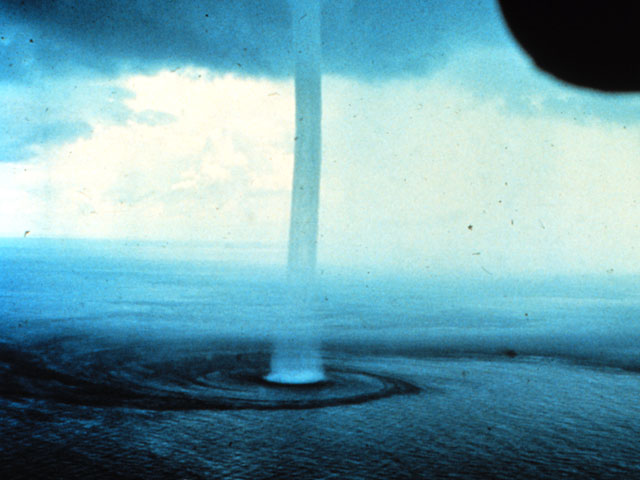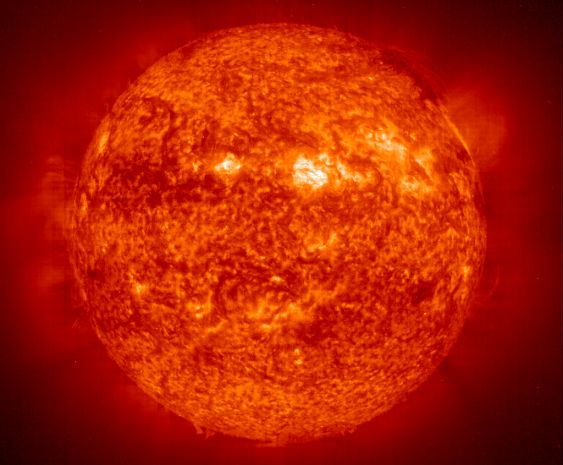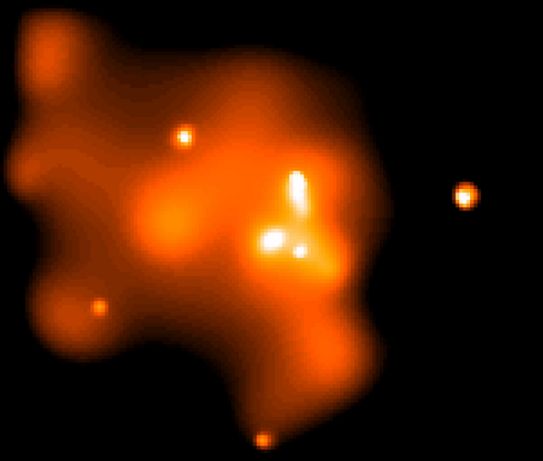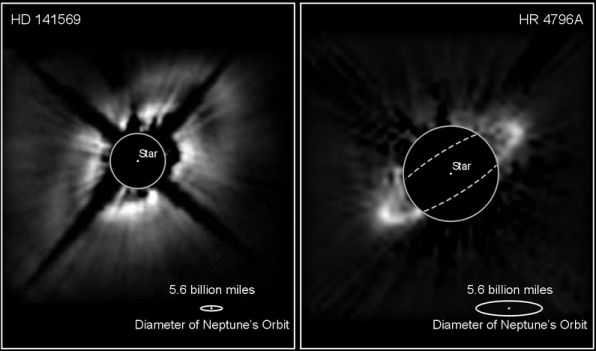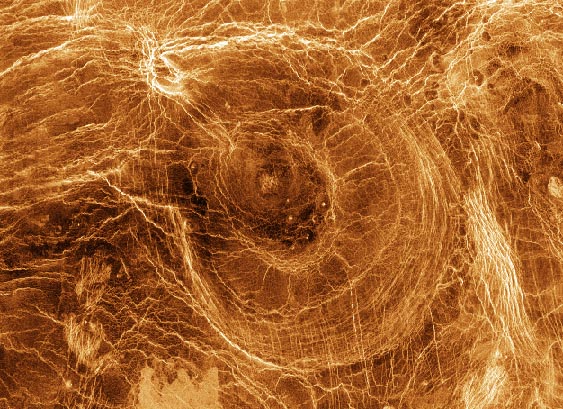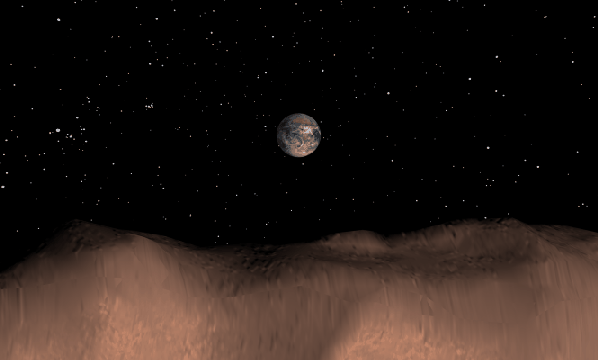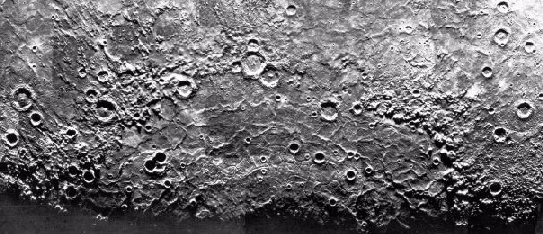| << Previous | Index | Next >> |
2015 It is the largest asteroid in the asteroid belt -- what secrets does it hold? To find out, NASA has sent the robotic Dawn spacecraft to explore and map this cryptic 1,000-kilometer wide world: Ceres. Orbiting between Mars and Jupiter, Ceres is officially categorized as a dwarf planet but has never been imaged in detail. Featured here is a 20-frame video taken a week ago of Dawn's approach that now rivals even the best images of Ceres ever taken by the Hubble Space Telescope. The video shows enough surface definition to discern its 9-hour rotation period. On target to reach Ceres in early March, Dawn will match speeds and attempt to orbit this previously unexplored body, taking images and data that may help humanity better understand not only the nature and history of Ceres but also the early history of our entire Solar System.
2014 How large do things appear when far away? When peering across the universe, the answer can actually tell us about its average gravitational history and hence its composition. Toward this goal, the Baryon Oscillation Spectroscopic Survey (BOSS) of the Sloan Digital Sky Survey-III (SDSS-III) has measured slight recurring density enhancements in galaxy densities up to six billion light years away (redshift 0.7), when the universe was about half its current age. These density ripples are known as baryon acoustic oscillations (BAOs) and are expected to emerge from the early universe at a known size scale. BOSS's measurements of this size scale indicate a strong universe component of dark energy, and so bolsters previous indications of this unusual composition. Pictured above is an artist's illustration depicting exaggerated BAOs in the distant universe.
2013 What is it? It was found at the bottom of the sea aboard an ancient Greek ship. Its seeming complexity has prompted decades of study, although some of its functions remained unknown. X-ray images of the device have confirmed the nature of the Antikythera mechanism, and discovered several surprising functions. The Antikythera mechanism has been discovered to be a mechanical computer of an accuracy thought impossible in 80 BC, when the ship that carried it sank. Such sophisticated technology was not thought to be developed by humanity for another 1,000 years. Its wheels and gears create a portable orrery of the sky that predicted star and planet locations as well as lunar and solar eclipses. The Antikythera mechanism, shown above, is 33 centimeters high and therefore similar in size to a large book.
2012 A Full Moon rising can be a dramatic celestial sight, and Full Moons can have many names. Captured on January 8 from Östersund, Sweden, this evocative moonrise portrait might make you feel the cold of winter in the north. If you can also imagine wolves howling in the distance then you probably understand why Native Americans would have called it the Wolf Moon, their traditional name for the first Full Moon in January. The photographer reports that no wolves were heard though, as he watched this beautiful Full Moon rise in fading light over the eastern horizon, echoing the yellow color of the setting Sun. Of course, due this year on February 7, the next Full Moon will be the Snow Moon.
2011 The big, beautiful Andromeda Galaxy, aka M31, is a spiral galaxy a mere 2.5 million light-years away. Two space-based observatories have combined to produce this intriguing composite image of Andromeda, at wavelengths outside the visible spectrum. The remarkable view follows the locations of this galaxy's once and future stars. In reddish hues, image data from the large Herschel infrared observatory traces enormous lanes of dust, warmed by stars, sweeping along Andromeda's spiral arms. The dust, in conjunction with the galaxy's interstellar gas, comprises the raw material for future star formation. X-ray data from the XMM-Newton observatory in blue pinpoint Andromeda's X-ray binary star systems. These systems likely contain neutron stars or stellar mass black holes that represent final stages in stellar evolution. More than twice the size of our own Milky Way, the Andromeda Galaxy is over 200,000 light-years across.
2010
Click to play embedded YouTube video.
Credit & Copyright: American Museum of Natural History
2009 If you could stand on Mars -- what could you see? One memorable vista might be the above 360-degree panoramic image taken by the robotic Spirit rover over the last year. The above image involved over 200 exposures and was released as part of Spirit's five year anniversary of landing on the red planet. The image was taken from the spot that Spirit stopped to spend the winter, near an unusual plateau called Home Plate. Visible on the annotated image are rocks, hills, peaks, ridges, plains inside Gusev crater, and previous tracks of the rolling Spirit rover. The image color has been closely matched to what a human would see, and named for the famous space artist Chesley Bonestell.
2008 Comet McNaught was perhaps the most photogenic comet of our time. After making quite a show in the northern hemisphere in early January, the comet moved south and developed a long and unusual dust tail that dazzled southern hemisphere observers. In this image, Comet McNaught was captured one year ago above Chile. The bright comet dominates on the left while part of its magnificent tail spreads across the entire picture. From this vantage point in the Andes Mountains, one looks up toward Comet McNaught and a magnificent sky, across at a crescent moon, and down on clouds, atmospheric haze, and the city lights of Santiago. Comet McNaught has glided into the outer Solar System and is now only visible as a speck in a large telescope. The other spectacular comet of 2007, Comet Holmes, has also faded from easy view.
2007 This frame from a spectacular time lapse movie shows Comet McNaught - the Great Comet of 2007 - sweeping through the inner solar system. The movie frames were recorded from January 12 through Jan 16 by a coronograph onboard the sun-staring SOHO spacecraft. Bright planet Mercury also glides dramatically through the field of view but the Sun itself remains fixed, hidden behind the coronograph's central occulting disk. The broad-tailed comet is so bright it almost overwhelms SOHO's sensitive camera designed to explore the fainter structures in the Sun's outer atmosphere. Comet McNaught's closest approach to the Sun (perihelion on January 12) was only 0.17 astronomical units, or about half the distance between the Sun and Mercury. (Note: To view the movie file, click here.)
2006 This esthetic close-up of cosmic clouds and stellar winds features LL Orionis, interacting with the Orion Nebula flow. Adrift in Orion's stellar nursery and still in its formative years, variable star LL Orionis produces a wind more energetic than the wind from our own middle-aged Sun. As the fast stellar wind runs into slow moving gas a shock front is formed, analogous to the bow wave of a boat moving through water or a plane traveling at supersonic speed. The small, arcing, graceful structure just above and left of center is LL Ori's cosmic bow shock, measuring about half a light-year across. The slower gas is flowing away from the Orion Nebula's hot central star cluster, the Trapezium, located off the upper left corner of the picture. In three dimensions, LL Ori's wrap-around shock front is shaped like a bowl that appears brightest when viewed along the "bottom" edge. The beautiful picture is part of a large mosaic view of the complex stellar nursery in Orion, filled with a myriad of fluid shapes associated with star formation.
2005 What's happening over the water? Pictured above is one of the better images yet recorded of a waterspout, a type of tornado that occurs over water. Waterspouts are spinning columns of rising moist air that typically form over warm water. Waterspouts can be as dangerous as tornadoes and can feature wind speeds over 200 kilometers per hour. Many waterspouts form away from thunderstorms and even during relatively fair weather. Waterspouts may be relatively transparent and initially visible only by the unusual pattern they create on the water. The above image was taken in 1969 from an aircraft off the Florida Keys, a location arguably the hottest spot for waterspouts in the world with hundreds forming each year. Some people speculate that these waterspouts are responsible for many of the losses recorded in the Bermuda Triangle region of the Atlantic Ocean.
2004 How could such a long string of galaxies form so early in the universe? Several new measurements of galaxies and clusters in the early universe are reporting structures involving galaxies and clusters that are larger than expected with the new standard "dark-energy" cosmology. The controversy centers on the inability of a dark-energy dominated universe to create such large structures. Fans of the old standard cosmology -- without weird but pervasive dark energy -- are hoping that these new measurements rule out the newly popular strange universe. Previously, however, data taken from several independent sources over the past few years has only appeared to bolster the bold new universe paradigm. A compromise is still possible if the new data is not typical or if the comparison computer simulations are not properly biased. Pictured above is a computer-generated illustration of a universe that shows a string of galaxies of the size measured. The size of the superimposed box is about 300 million light years on a side.
2003 How tall are mountains on Jupiter's moon Io? One way to find out is to view them at sunset. Tall structures facing the Sun are then better-lit and cast long shadows. The above image highlights Mongibello Mons on the far left, a sharp ridge rising so high it would rank among the highest mountains on Earth. The violently changing surface of Io shows not only classic volcano cinder cones but also many thrust faults where the ground has fractured and created dramatic shear cliffs. The grayscale image was taken two years ago by the robot spacecraft Galileo currently orbiting Jupiter.
2002 Callisto's surface shows its age. While probably formed at the same time as Io, the difference between the surfaces of these two moons of Jupiter could hardly be greater. Io's surface is young, shows practically no impact craters, and is continually being repaved by the lava exploding from its many large volcanoes. Callisto's surface is old, shows the highest density of impact craters in the Solar System, and harbors no volcanoes or even any large mountains. Callisto's surface is one large ice-field, laced with cracks and craters from billions of years of collisions with interplanetary debris. The above image was taken in 2001 May and is, so far, the only complete global color image taken by the Jupiter-orbiting Galileo spacecraft.
2001 This image of the active Sun was made using ultraviolet light emitted by ionized Helium atoms in the Solar chromosphere. Helium was first discovered in the Sun in 1868, its name fittingly derived from from the Greek word Helios, meaning Sun. Credit for the discovery goes to astronomer Joseph Norman Lockyer (born May 17, 1836). Lockyer relied on a then recently developed technique of spectroscopy, dissecting sunlight into a spectrum, and the idea that each element produces a characteristic spectral pattern of bright lines. He noticed a yellow line in a solar spectrum made during an eclipse which could not be accounted for by elements known on Earth. Almost 27 years later terrestrial Helium was finally discovered when the spectrum of a Helium bearing mineral of Uranium provided an exact match to the previously detected element of the Sun. Helium is now known to be the second most abundant element (after Hydrogen) in the Universe.
2000 Exploring quasars and active galaxies in the distant universe, astronomers have come to believe that most galaxies have massive black holes at their centers. Swirling stars and a strong, variable radio source offer convincing evidence that even our own Milky Way galaxy's center harbors such a bizarre object, a mere 30,000 light-years away. Still, it has long been realized that if a massive black hole lurks there it should produce X-rays - which have not previously been identified. Now, though relatively faint, the missing X-ray source may have been found. Taking advantage of the sensitive Chandra Observatory astronomers have recorded this false-color X-ray image of the Galactic Center. Embedded in a diffuse cloud of X-ray hot gas, the white dot at the center corresponds to an X-ray source at exactly the position of the strong radio source and suspected black hole. Other individual X-ray sources are also present in the picture which spans about 10 light-years at the distance of the galactic center. With radio and X-ray emission generated by infalling material, the Milky Way's central black hole is thought to have a mass of over 2 million suns.
1999
1998 Arachnoids are large structures of unknown origin that have been found only on the surface of Venus. Arachnoids get their name from their resemblance to spider-webs. They appear as concentric ovals surrounded by a complex network of fractures, and can span 200 kilometers. Radar echoes from the Magellan spacecraft that orbited Venus from 1990 to 1994 built up this image. Over 30 arachnoids have been identified on Venus, so far. The Arachnoid might be a strange relative to the volcano, but possibly different arachnoids are formed by different processes.
1997 On November 29, 1996 the Earth came within 3.3 million miles of the asteroid Toutatis. Above is a computer simulated picture of this spectacle from the surface of Toutatis (a 2.5 degree field of view looking toward Earth). In Earth's sky, Toutatis appeared only as a faint object moving against a background of stars. Also known as Earth-crossing asteroid 4179, Toutatis is in an eccentric 4 year orbit which moves it from the asteroid belt between Mars and Jupiter to just inside Earth's orbit. When the Earth passed near it in 1992 Toutatis was imaged by radar and seen to be two irregularly shaped lumps, perhaps joined by a narrow neck. This bizarre object is up to 1.5 miles wide, 2.9 miles long, and is tumbling through space. In the year 2004, on September 29, the Earth will pass very near Toutatis, closing to within a million miles (4 times the Earth-Moon distance) - the closest approach predicted for any asteroid or comet between now and 2060. Studies of Toutatis and other Earth-crossing asteroids help reveal connections between the Solar System's meteorites,main-belt asteroids and comets. These wayward asteroids also offer tantalizing targets for robotic exploration and, over time, represent potential collision hazards for planet Earth!
1996 Mercury, the closest planet to the Sun, has a surface with so many craters it resembles the Earth's Moon. The largest surface feature on Mercury is the Caloris Basin, which resulted from a collision with an asteroid. The basin, which is more that 1000 kilometers across, is visible as the large circular feature at the bottom of the above photograph. Similar features, such as the Mare Orientale, are seen on the Moon. The Caloris Basin gets very hot because it is near the "sub-solar point" - the point on Mercury's surface that is directly under the Sun when Mercury is closest to the Sun.
| << Previous | Index | Next >> |
